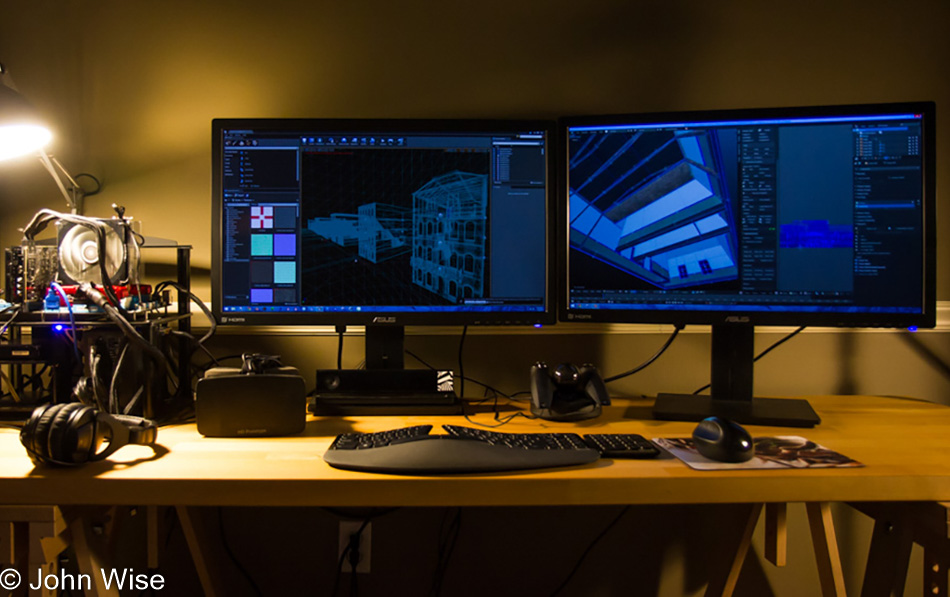
We are almost ready to tackle our objective of building some kick-ass Virtual Reality, but there are the hurdles of the unknown, unknowns of which some have been becoming known as time passes. There is much to do in order to build something as audacious as virtual reality. Knowledge is probably the biggest factor in proceeding with this endeavor, and we have to constantly check ourselves to verify if we have enough.
First, we have the gamut of hardware requirements. The computers we have built ourselves are based on Intel’s i7-4930k, 16GB of RAM (except one PC which needed 64GB of RAM – he’s the UE4 expert among us), EVGA GTX-780Ti’s, and some extraordinarily large 27″ Asus monitors that let us see a glorious 2560×1440 resolution each. We built them on open benchcases, so we are constantly reminded of the horsepower at our fingertips.
That’s not the only hardware we need. There is the matter of the Oculus Rift virtual reality headset, where we are allowed to peek into the immersive world of the virtual. Not only do we have a DK1 (Developers Kit ver. 1) that I acquired during their now-famous Kickstarter, but I also nabbed a prototype Oculus HD while at GDC back in March. Sitting on another desk is also a test unit from Microsoft of the Kinect 2, a Razer Hydra, a game controller, and some headphones that will allow us to hear sounds in the far away corners of the VR world we are building.
For software, we are exercising the low-budget muscles. Foremost among these tools is Epic’s Unreal Engine 4 (UE4). It was at the Game Developers Conference (GDC) in San Francisco that Epic crushed the dreams of other game engine developers while inflating ours with a price of only $19 a month per seat instead of the stratospheric prices of yore that were so exorbitant they couldn’t even be spoken. Next up in our arsenal is the open-source and FREE 3D software known as Blender. Without Blender, we would be faced with tens of thousands of dollars for our mesh creation and animation tools. Instead, we have saved a substantial amount of money that is being better spent on payroll. Equally as important to our workflow is Allegorithmic’s suite of tools: Substance Designer and Substance Painter. While we are presently on hold regarding the lack of easy-to-use native support or a friendly-to-use plugin that ties together UE4 and Substance, we are patient, and in any case, we have so much mesh modeling ahead of us along with filling those knowledge gaps I spoke of, we can wait. Rounding out our toolkit are 3D-Coat, MakeHuman, and TerreSculptor.
Right now, we are only three people, but we have the ability to hire others. We have to hold off bringing in others as there’s a lot for us to do now that we are formally a company and not a hobby. One guy is digging hard into UE4 to better understand Materials, Blueprints, splines, and plugins, compiling our own versions, and staying up with the crazy openness of Epic and their new philosophy of sharing everything. Brinn, being relatively new to mesh modeling and Blender, is spending 80 hours a week mastering this half of his responsibility to our new company. His other task will be our soundtrack and audio work. Me, well I’m knee-deep in business affairs and working through the kinks of our funding, though I have to say that the financial group we have behind us is amazing and has surprised me with the speed they stepped up to make it all happen. Thanks, guys, and especially Jeffrey Rassas who lead these efforts.